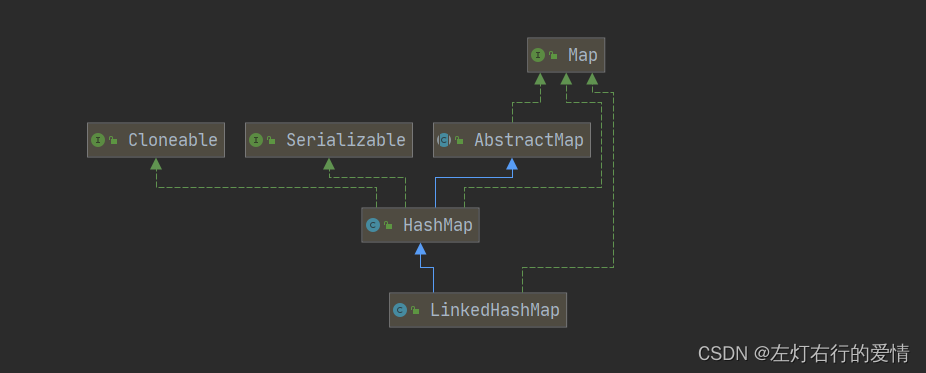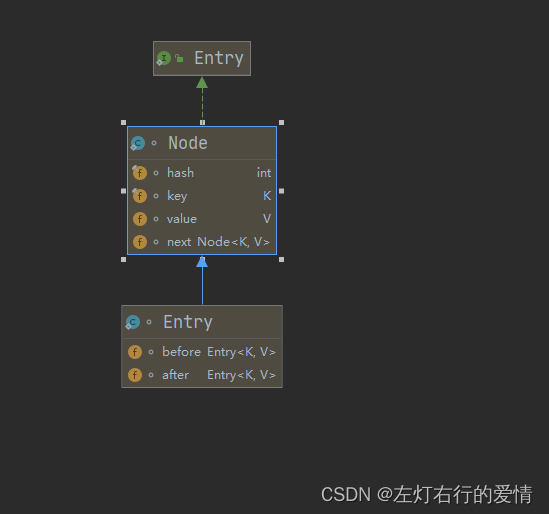前言
在我们刚学习LInkedList的时候我们知道,LinkedList实际上性能不会比ArrayList高很多,因为LinkedList只有在前向插入的时候性能才会比ArrayList高。
LinkedList虽然在remove和insert操作不需要拷贝数据,但是寻址需要时间(从链表中找到需要操作的节点),只能挨个遍历。
那么有没有一种数据结构,能够把查询链表某一个元素所需要的时间复杂度O(n)变为O(1)呢?
LInkedHashMap就是这样的一种数据结构,综合了HashMap和链表的有点,虽然数据结构相对来说比较复杂,但是在某些场景下,性能要更好一些。
继承结构关系

代码实现:
public class LinkedHashMap<K,V>
extends HashMap<K,V>
implements Map<K,V>
这个我觉得不必多说了。
Doc解析
/**
* <p>Hash table and linked list implementation of the <tt>Map</tt> interface,
* with predictable iteration order.
* Map接口的hash表和链表实现,具有可预测的迭代顺序
*
* This implementation differs from <tt>HashMap</tt> in that it maintains a doubly-linked list running through all of its entries.
* 此实现与hashMap不同之处在于它维护了一个贯穿其所有entry的双向列表
* This linked list defines the iteration ordering,which is normally the order in which keys were inserted into the map (<i>insertion-order</i>).
* 这个链表定义了迭代排序,通常是通过键插入映射的顺序(插入顺序)
* Note that insertion order is not affected if a key is <i>re-inserted</i> into the map. 注意,如果将键重新插入,不会影响插入顺序
* (A key <tt>k</tt> is reinserted into a map <tt>m</tt> if <tt>m.put(k, v)</tt> is invoked when <tt>m.containsKey(k)</tt> would return <tt>true</tt> immediately prior tothe invocation.)
*一个键k重新插入map集合m,其迭代顺序不会改变,
* <p>This implementation spares its clients from the unspecified, generally
* chaotic ordering provided by {@link HashMap} (and {@link Hashtable}),
* without incurring the increased cost associated with {@link TreeMap}.
* 这个实现避免了用户使用hashMap和hashtable提供的未指定的,混乱的排序,同时又不会像TreeMap那样为了达到有序而带来额外的开销。
* It can be used to produce a copy of a map that has the same order as the
* original, regardless of the original map's implementation:
* 它可以生成一些具有原始顺序的副本,在实现过程中完全不考虑原始的实现
* <pre>
* void foo(Map m) {
* Map copy = new LinkedHashMap(m);
* ...
* }
* </pre>
* This technique is particularly useful if a module takes a map on input,
* copies it, and later returns results whose order is determined by that of
* the copy. (Clients generally appreciate having things returned in the same
* order they were presented.)
*如果一个模块输入的时候获取一个map,然后返回结果,其顺序由复制时的顺序而决定,这种技术非常有用
(客户通常喜欢按提交的顺序返回物品)
* <p>A special {@link #LinkedHashMap(int,float,boolean) constructor} is
* provided to create a linked hash map whose order of iteration is the order
* in which its entries were last accessed, from least-recently accessed to
* most-recently (<i>access-order</i>).
* 特殊的构造函数LinkedHashMap(int,float,boolean) 提供创建迭代顺序为上次访问顺序的链表hash结构,
* This kind of map is well-suited to building LRU caches.
* 这种map能很好的构建LRU缓存
* Invoking the {@code put}, {@code putIfAbsent}, {@code get}, {@code getOrDefault}, {@code compute}, {@code computeIfAbsent}, {@code computeIfPresent}, or {@code merge} methods results in an access to the corresponding entry (assuming it exists after the invocation completes).
* 调用put、 get、getOrDefault、compute、computeIfPresent、merge等方法将导致对应条目的访问(假设它在调用完成后存在)。
The {@code replace} methods only result in an access of the entry if the value is replaced.
仅仅在值会替换的时候,replace才会访问条目
The {@code putAll} method generates one entry access for each mapping in the specified map, in the order that key-value mappings are provided by the specified map's entry set iterator.
putAll方法为指定映射中的每个映射生成一个条目访问,顺序是指映射的条目和迭代器提供的键值映射
<i>No other methods generate entry accesses.</i>
* 没有其他的访问生成入口要访问。
In particular, operations on collection-views do <i>not</i> affect the order of iteration of the backing map.
通常情况下,对集合视图操作不会影响备份映射的迭代顺序
* <p>The {@link #removeEldestEntry(Map.Entry)} method may be overridden to impose a policy for removing stale mappings automatically when new mappings are added to the map.
* removeEldestEntry(Map.Entry)方法可能会被重写,以便向Map中添加新的映射时强制执行一个策略,以便自动删除过时的映射。
*
* <p>This class provides all of the optional <tt>Map</tt> operations, and
* permits null elements.
* 此类提供所有可选的map操作,并允许null元素。
* Like <tt>HashMap</tt>, it provides constant-time performance for the basic operations (<tt>add</tt>, <tt>contains</tt> and <tt>remove</tt>), assuming the hash function disperses elements* properly among the buckets.
* 像HashMap,它提供了操作有恒定常数级时间的表现(add,contains,remove),假设hash有足够的离散,元素都分布在各个桶中
* Performance is likely to be just slightly below that of <tt>HashMap</tt>, due to the added expense of maintaining the linked list, with one exception:
* 性能只比HashMap略低,比链表时间略高。但有一个情况例外:
* Iteration over the collection-views of a <tt>LinkedHashMap</tt> requires time proportional to the <i>size</i>of the map, regardless of its capacity.
* 对于LinkedHashMap的集合视图进行迭代所需的时间与映射大小成正比,无论容量如何。
* Iteration over a <tt>HashMap</tt> is likely to be more expensive, requiring time proportional to its <i>capacity</i>.
*在HashMap上迭代的性能可能比较低,需要的时间与其桶的数量有关。
* <p>A linked hash map has two parameters that affect its performance:
* <i>initial capacity</i> and <i>load factor</i>.
* LInkedHashMap有两个参数会影响性能:初始容量和负载因子
* They are defined precisely as for <tt>HashMap</tt>.
* 他们在HashMap中有精确的定义。
* Note, however, that the penalty for choosing an excessively high value for initial capacity is less severe for this class than for <tt>HashMap</tt>, as iteration times for this class are unaffected by capacity.
* 但是注意,对于LinkedHashMap来说,一旦初始容量选择过高带来的弊端比HashMap要轻,因为LinkedHashMap的迭代次数不受容量的影响。
*
* <p><strong>Note that this implementation is not synchronized.</strong>
* LinkedHashMap是不同步的
* If multiple threads access a linked hash map concurrently, and at least
* one of the threads modifies the map structurally, it <em>must</em> be
* synchronized externally.
* 如果多个线程需要同时访问,并且至少有一个线程在结构上对其进行了修改,则它必须在外部同步。
* This is typically accomplished by synchronizing on some object that naturally encapsulates the map.
*这通常是在一些自然封装的映射的对象上来同步实现的。
* If no such object exists, the map should be "wrapped" using the
* {@link Collections#synchronizedMap Collections.synchronizedMap}
* method. This is best done at creation time, to prevent accidental
* unsynchronized access to the map:<pre>
*
* Map m = Collections.synchronizedMap(new LinkedHashMap(...));</pre>
*如果没有这样的对象,那么应该用Collections.synchronizedMap将这个对象包裹。最好在对象创建的时候就完成,以免造成非同步的访问。Map m = Collections.synchronizedMap(new LinkedHashMap(...));
* A structural modification is any operation that adds or deletes one or more
* mappings or, in the case of access-ordered linked hash maps, affects
* iteration order.
* 结构修改时添加或者删除一个或者多个操作的任何映射操作。或者在访问顺序LinkedHashMap的情况下,影响其迭代顺序的任何操作。
* In insertion-ordered linked hash maps, merely changing the value associated with a key that is already contained in the map is not a structural modification.
* 在插入顺序的LinkedHashMap中,仅仅是更改map中已包含的key相关的值不是结构修改。
* <strong>In access-ordered linked hash maps, merely querying the map with <tt>get</tt> is a structural modification. </strong>)
*在有访问顺序的linkedHashmap中,仅仅使用get进行查询也是一种结构修改。
* <p>The iterators returned by the <tt>iterator</tt> method of the collections
* returned by all of this class's collection view methods are <em>fail-fast</em>:
* if the map is structurally modified at any time after the iterator is created, in any way except through the iterator's own <tt>remove</tt> method, the iterator will throw a {@link ConcurrentModificationException}.
* 类的所有集合视图方法返回的collections的iterator方法都是fail-fast的。
* 如果迭代器在创建之后任何时候被修改,以任何方式(除了迭代器自己的remove)对map进行修改。迭代器将抛出ConcurrentModificationException。
* Thus, in the face of concurrent
* modification, the iterator fails quickly and cleanly, rather than risking
* arbitrary, non-deterministic behavior at an undetermined time in the future.
*因此在并发修改的情况下,迭代器会快速的失败,而不是将来在某个不确定的时间,冒着任意的的不确定的风险。
* <p>Note that the fail-fast behavior of an iterator cannot be guaranteed
* as it is, generally speaking, impossible to make any hard guarantees in the
* presence of unsynchronized concurrent modification.
* 需要注意的是迭代器的fail-fast行为不能得到保证,因为一般来说,存在不同步的并发修改时不可能做出任何保证。
* Fail-fast iterators
* throw <tt>ConcurrentModificationException</tt> on a best-effort basis.
* fail-fast机制尽力的抛出了ConcurrentModificationException,
* Therefore, it would be wrong to write a program that depended on this
* exception for its correctness: <i>the fail-fast behavior of iterators
* should be used only to detect bugs.</i>
*因此在编写一个依赖于这个异常来保证其正确性的程序是错误的。迭代器的fail-fast机制只用于检测bug。
数据结构

我们需要注意,LinkedHashMap实际上是一个Entry节点链入双向链表的HashMap,通过维护一个Entry的双向链表,保证了插入Entry中顺序
Entry内部类
(1):Entry的继承结构

代码实现:
/**
* HashMap.Node subclass for normal LinkedHashMap entries.
*/
static class Entry<K,V> extends HashMap.Node<K,V> {
Entry<K,V> before, after;
Entry(int hash, K key, V value, Node<K,V> next) {
super(hash, key, value, next);
}
}
Entry主要作用是实现对Node节点的链表化。
构建一个新的双向链表来作为HashMap的扩展。
之后LinkedHashMap可以作为链表使用。
Entry抓哟增加了before和after两个指针,以将HashMap的全部Entry转成成双向链表
成员变量&&静态变量
成员变量:
/**
* The head (eldest) of the doubly linked list.
*/
transient LinkedHashMap.Entry<K,V> head;双向链表的头部
/**
* The tail (youngest) of the doubly linked list.
*/
transient LinkedHashMap.Entry<K,V> tail;双向链表的尾部
/**
* The iteration ordering method for this linked hash map: <tt>true</tt>
* for access-order, <tt>false</tt> for insertion-order.
*
* @serial
*/
final boolean accessOrder;链表的迭代顺序,true---按访问顺序(最近访问的元素将被移动到head),false---插入顺序
这三个变量都用了translent修饰。
静态变量:
private static final long serialVersionUID = 3801124242820219131L; 序列号
构造函数
五种构造方法:
1:无参构造
public LinkedHashMap() {
super(); //使用默认初始大小和负载因子0.75
accessOrder = false; //链表的迭代顺序是插入迭代
}
super:
public HashMap() {
this.loadFactor = DEFAULT_LOAD_FACTOR; // all other fields defaulted
}
2:有参构造(参数为初始容量)
public LinkedHashMap(int initialCapacity) {
super(initialCapacity);
accessOrder = false;
}
/**
* Constructs an empty <tt>HashMap</tt> with the specified initial
* capacity and the default load factor (0.75).
*
* @param initialCapacity the initial capacity.
* @throws IllegalArgumentException if the initial capacity is negative.
*/
public HashMap(int initialCapacity) {
this(initialCapacity, DEFAULT_LOAD_FACTOR);
}
3:有参构造(参数为初始容量和负载因子)
public LinkedHashMap(int initialCapacity, float loadFactor) {
super(initialCapacity, loadFactor);
accessOrder = false;
}
public HashMap(int initialCapacity, float loadFactor) {
if (initialCapacity < 0)
throw new IllegalArgumentException("Illegal initial capacity: " +
initialCapacity);
if (initialCapacity > MAXIMUM_CAPACITY)
initialCapacity = MAXIMUM_CAPACITY;
if (loadFactor <= 0 || Float.isNaN(loadFactor))
throw new IllegalArgumentException("Illegal load factor: " +
loadFactor);
this.loadFactor = loadFactor;
this.threshold = tableSizeFor(initialCapacity);
}
4:有参构造(参数为集合)
public LinkedHashMap(Map<? extends K, ? extends V> m) {
super();
accessOrder = false;
putMapEntries(m, false);
}
super为:
public HashMap() {
this.loadFactor = DEFAULT_LOAD_FACTOR; // all other fields defaulted
}
5:有参构造(参数为初始容量,负载因子,迭代顺序)
public LinkedHashMap(int initialCapacity,
float loadFactor,
boolean accessOrder) {
super(initialCapacity, loadFactor);
this.accessOrder = accessOrder;
}
LinkedHashMap存取
我们先来看存储
你在LinkedHashMap的源码中找不到put方法,因为它完美继承了HashMap的put(Key,Value)的方法
其源码:
public V put(K key, V value) {
return putVal(hash(key), key, value, false, true);
}
核心方法是putVal:
* @param hash hash for key // hash值
* @param key the key //key值
* @param value the value to put // value值
* @param onlyIfAbsent if true, don't change existing value /这里onlyIfAbsent为false即在key值相同的时候,用新的value值替换原始值,如果为ture,则不改变value值
* @param evict if false, the table is in creation mode. 表是否在创建模式,如果为false,则表是在创建模式。
* @return previous value, or null if none
*/
final V putVal(int hash, K key, V value, boolean onlyIfAbsent,
boolean evict) {
Node<K,V>[] tab;
Node<K,V> p;
int n, i;
//如果当前HashMap的table数组还未定义或者还没有初始化长度,则先通过扩容resize()进行扩容,并返回扩容后的长度n。
if ((tab = table) == null || (n = tab.length) == 0)
n = (tab = resize()).length;
通过数组的长度与hash值做&运算,如果为空则当前创建的节点就是根节点
if ((p = tab[i = (n - 1) & hash]) == null)
tab[i] = newNode(hash, key, value, null);
//若该位置已经有元素了,我们需要进行一些操作
else {
Node<K,V> e;
K k;
//如果插入的key与原来的key相同,则进行替换
if (p.hash == hash &&
((k = p.key) == key || (key != null && key.equals(k))))
e = p;
//如果key不同的情况下,判断当前Node是否为TreeNode,如果是则执行putTreeVal将新的元素插入到红黑树上
else if (p instanceof TreeNode)
e = ((TreeNode<K,V>)p).putTreeVal(this, tab, hash, key, value);
//如果不是TreeNode,则进行链表的遍历
else {
for (int binCount = 0; ; ++binCount) { //注意这里循环没有终止条件
//如果在链表最后一个节点之后没有找到相同的元素,则直接new Node插入
if ((e = p.next) == null) {
p.next = newNode(hash, key, value, null);
//如果此时binCount从0开始超过了8(包含8),转为红黑树(但这里并不是直接转,因为进到treeifyBin还有一个判断是HashMap容量是否大于64,HashMap从链表转化为红黑树一定是两个条件都符合)
if (binCount >= TREEIFY_THRESHOLD - 1) // -1 for 1st
treeifyBin(tab, hash);
break;
}
//如果在最后一个链表节点之前找到key值相同的节点(上面那个是通过数组的下标,和这个不相同),则替换
if (e.hash == hash &&
((k = e.key) == key || (key != null && key.equals(k))))
break;
p = e;
}
}
如果上面我们找到了对应key的的Node节点,如果不存在上面会新建节点,这里对e的值数据进行处理
if (e != null) { // existing mapping for key
V oldValue = e.value;
if (!onlyIfAbsent || oldValue == null)
e.value = value;
afterNodeAccess(e);
return oldValue;
}
}
++modCount;
//判断临界值,是否扩容。
if (++size > threshold)
resize(); //扩容方法
afterNodeInsertion(evict); //插入之后的平衡操作
return null;
}
我们回头去看HashMap中的put方法,可以发现,putVal是final修饰的,这意味着LinkedHashMap无法重写这个方法。
由于putVal中全部都是对HashMap是否需要树化的操作,HashMap是否考虑到put之后链表的关系如何维护呢?
实际上在HashMap中的putVal中,已经预留了后处理的方法:
// Callbacks to allow LinkedHashMap post-actions
void afterNodeAccess(Node<K,V> p) { } //访问
void afterNodeInsertion(boolean evict) { } //插入
void afterNodeRemoval(Node<K,V> p) { } //删除
这三个方法在HashMap中都是空实现,为了预留给LinkedHashMap进行使用的。
我们可以称他们为维护链表的操作,接下来我们一个个进行分析:
1:afterNodeAccess:
//在节点被访问后根据accessOrder判断是否需要调整链表顺序,如果accessOrder为true,那么被access的节点就要移动到tail(尾部,也就是最新的节点)
void afterNodeAccess(Node<K,V> e) { / / move node to last
LinkedHashMap.Entry<K,V> last; //链表尾节点
//判断当前accessOrder是否为true,且当前节点不为尾结点
if (accessOrder && (last = tail) != e) {
LinkedHashMap.Entry<K,V> p =
(LinkedHashMap.Entry<K,V>)e, //p指向待删除元素
b = p.before,
a = p.after;
// 将p的after置为null
p.after = null;
if (b == null) //如果e前面没有节点,将e后面的节点置为首节点
head = a;
else //如果e前面有节点,将e前面节点的后置指针指向e后面的节点
b.after = a;
if (a != null) //如果e后面有节点,将后面节点的前置节点指向e前面节点
a.before = b;
else //如果e后面没有节点,将e前面节点置为尾结点
last = b;
if (last == null) 将p放在尾部
head = p;
else {
p.before = last;
last.after = p;
}
tail = p;
++modCount;
}
}
2:afterNodeInsertion
void afterNodeInsertion(boolean evict) { // possibly remove eldest
LinkedHashMap.Entry<K,V> first;
if (evict && (first = head) != null && removeEldestEntry(first)) {
K key = first.key;
removeNode(hash(key), key, null, false, true);
}
}
protected boolean removeEldestEntry(Map.Entry<K,V> eldest) {
return false;
}
这个方法目的是删除最老的节点(head节点),但是这个方法默认是不执行的,留给我们自己扩展,因为removeEldestEntry默认为false。
3:afterNodeRemoval
void afterNodeRemoval(Node<K,V> e) { // unlink
LinkedHashMap.Entry<K,V> p =
(LinkedHashMap.Entry<K,V>)e, b = p.before, a = p.after;
p.before = p.after = null;
if (b == null)
head = a;
else
b.after = a;
if (a == null)
tail = b;
else
a.before = b;
}
这个方法目的是删除元素之后,将这个元素的前后元素重写组成链表。
现在我们来看读取方法get:
public V get(Object key) {
Node<K,V> e;
if ((e = getNode(hash(key), key)) == null)
return null;
if (accessOrder)
afterNodeAccess(e);
return e.value;
}
实际上get方法调用的还是HashMap中的getNode,之后再调用afterNodeAccess进行整理。
而accessOrder方法最关键的就是通过这个afterNodeAccess方法来调整链表顺序。
final Node<K,V> getNode(int hash, Object key) {
Node<K,V>[] tab;
Node<K,V> first, e;
int n; K k;
//通过位运算计算桶位置
if ((tab = table) != null && (n = tab.length) > 0 &&
(first = tab[(n - 1) & hash]) != null) {
if (first.hash == hash && // always check first node
((k = first.key) == key || (key != null && key.equals(k))))
如果hash值相同,则判断key是否相等
return first;
如果不等则遍历链表或者红黑树
if ((e = first.next) != null) {
if (first instanceof TreeNode)
return ((TreeNode<K,V>)first).getTreeNode(hash, key);
do { // 遍历链表
if (e.hash == hash &&
((k = e.key) == key || (key != null && key.equals(k))))
return e;
} while ((e = e.next) != null);
}
}
return null;
}
get方法中核心的就是根据hash值,从链表或者红黑树中搜索结果。如果为红黑树,则通过红黑树的方式查找。因为红黑树是颗排序的树,红黑树的效率会比链表全表扫描有显著提高。
结束语
LinkedHashMap可以理解为HashMap又维护了一个双向链表,所以我们理解了HashMap,LinkedHashMap就很容易理解,本文把比较核心的内容解析了一下,还有一些零碎的用法,如果你有需要去看一下源码,有了这些铺垫,相信理解起来就很容易了。






















 709
709











 被折叠的 条评论
为什么被折叠?
被折叠的 条评论
为什么被折叠?








